![]()
![]()
![]()
Use LEFT and RIGHT arrow keys to navigate between flashcards;
Use UP and DOWN arrow keys to flip the card;
H to show hint;
A reads text to speech;
10 Cards in this Set
- Front
- Back
- 3rd side (hint)
|
Gas exchange in plants and adaptations |
¤ Diffusion. ¤ Leaves are thin to shorten diffusion distances. ¤ A large surface area for more efficient rate of diffusion. ¤ Air spaces in the membrane to allow gases to pass through. |
|
|
|
Leaf adaptations for photosynthesis |

¤ Large surface area for efficient light harvesting. ¤ Ability to move by growth to the best position. ¤ Palisade mesophyll cells are elongated and densely arranged in a layer. Contain may chloroplasts which arrange themselves according to the light intensity. ¤ Light can pass through to the spongy mesophyll. |
|
|
|
What enables gases to diffuse across the membrabe of a leaf |
¤ The spaces between mesophyll cells allow CO2 to diffuse to the cells and oxygen to diffuse out. ¤ The cells are moist so gases can dissolve. ¤ The presence of pores (stomata) allow water and gases through. ¤ The lower side of the leaf has more stomata for gas exchange. |
|
|
|
What does xylem do? |
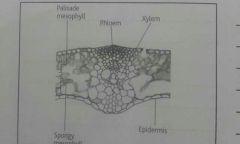
It brings water |
|
|
|
What does phloem do? |
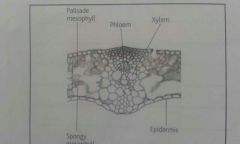
Takes away the products of photosynthesis as sucrose |
|
|
|
How is water loss prevented? |

¤ Waxy cuticle on the leaves. However also reduces gasous exchange. ¤ Stomata close at night; controlled by changes in the shape of guard cells |
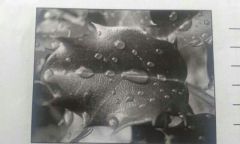
|
|
|
How do guard cells control opening and closing of the stomata? |
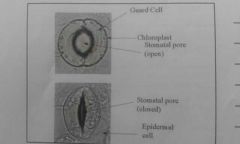
¤ Change shape to open and close the stomata and help to control the gas exchange and water loss ¤ Change shape because of changes in turgor ¤ Guard cells are swollen when stomata are open ¤ Guards cells shrunken when stomata are closed |
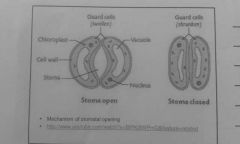
|
|
|
Stomatal opening in detail |
¤ In the light, water moves in by osmosis ¤ Cells expand and become turgid ¤ Inner walls are thicker and more inelastic then the outer walls therefore they curve away from each other and the pore opens ¤ Caused by the movement of potassium ions (active process and requires ATP) ¤ Potassium ions move from the epidermal cells into the guard cells ¤ A more negative wateer potential is creater in the guard cells by converting stored starch into soluble malate ¤ Stomatal closing is the reverse process |
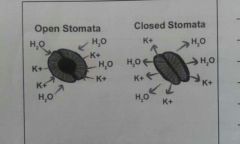
|
|
|
Ions invoved in the stomatal opening |
Potassium ions from epidermal cells move by active transport into the guard cells which requires ATP |
|
|
|
What makes the water potential inside the guard cells more negative |
Stored starch is converted to soluble malate |
|

